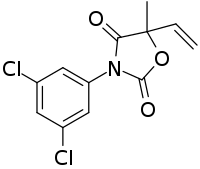Dicarboximide fungicides
Dicarboximide (or dicarboxamide) fungicides are a family of agricultural fungicides that include vinclozolin, iprodione, and procymidone.[1] Dicarboximides are believed to inhibit triglyceride biosynthesis in sclerotia-forming fungi, including Botrytis cinerea.[2] These fungicides turn into 3,5-dichloroaniline in soil rapidly. Repeated use of dicarboximides over several years reduce their effectiveness. Resistance has developed against all dicarboximides in many plant species, including vines, strawberries and protected crops, and are recommended to be used in conjunction with other fungicides.[1][2]

Toxicity
Dicarboximides are endocrine disruptors and have been shown to have antiandrogenic effects, i.e. decrease levels of male hormones.
Animal studies with vinclozolin and procymidone show irregular reproductive development due to their function as androgen receptor antagonists that inhibit androgen-activated gene expression.[3][4] Even with low doses of antiandrogenic pesticides, developmental effects such as reduced anogenital distance and induction of areolas were seen in male rats.[3]
References
- Noon, Robert (2004), New developments in Fungicides (2004 ed.), PJB Publications, p. 38
- Copping, L. G. (1998). "Review of major agrochemical classes and uses". In: Chemistry and Technology of Agrochemical Foundations (D. Alan Knowles ed.). Dordrecht; Boston: Kluwer Academic Publishers, p. 29. ISBN 0-7514-0443-8.
- Gray LE, Ostby J, Furr J, Wolf CJ, Lambright C, Parks L, Veeramachaneni DN, Wilson V, Price M, Hotchkiss A, Orlando E, Guillette L (2001). "Effects of environmental antiandrogens on reproductive development in experimental animals". Human Reproduction Update. 7 (3): 248–64. doi:10.1093/humupd/7.3.248. PMID 11392371.
- Curtis LR. (Mar 2001). "Organophosphate antagonism of the androgen receptor". Toxicological Sciences. 60 (1): 1–2. doi:10.1093/toxsci/60.1.1. PMID 11222865.